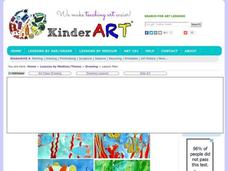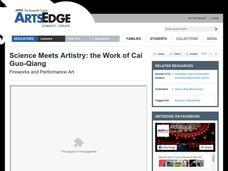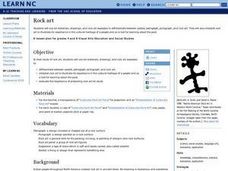Curated OER
Under the Sea
Tropical fish are a great subject for any art project, they are colorful, interesting, and can go along with under water themed stories read in class, learner written narratives, or Marine Biology units. This set of instructions will...
PBS
Lesson Plan: Divided Opinions
To gain a more in-depth understanding of the tumultuous 1960s, young historians examine video clips, listen to music, examine images, and interview survivors. Once they have a foundation of information about the period, class members...
Curated OER
The Art of Protesting
Students view various images to examine different types of protest Americans have used throughout history, and explore ways in which protest can produce change for better or worse.
EngageNY
End of Unit Assessment: Analyzing the Structure of Chávez’s Wrath of Grapes Speech
César Chávez gave his 1986 "Wrath of Grapes" speech to educate consumers about pesticide use. Scholars complete an end of unit 2 assessment, applying what they learned throughout the unit to a new text. They then analyze the structure of...
Curated OER
Shaping Ideas: Symbolism in Sculpture
Students critique the symbolic structures created by other students. In this visual arts lesson, students display completed sculptures and drawings. Students analyze the symbolic elements in each others work, relate their art to Getty's...
Curated OER
Out and About: Sculpture
Students take a closer look at sculpture. In this visual arts instructional activity, students may visit the Yorkshire Sculpture Park, the New Art Center Sculpture Park, the Fruitmarket Gallery, or Tate Britain online or in-person to...
Curated OER
Science Meets Artistry: the Work of Cai Guo-Qiang
Students discuss and examine the work of artist Cai Guo-Qiang. In this art lesson, students analyze how cultural and historical factors impact the visual arts.
Curated OER
Rock art
Students study rock art they use art materials, colored photographs and rock art examples to: differentiate between symbol, petroglyph, pictograph, and rock art. They interpret rock art to illustrate its importance in the cultural...
Curated OER
Historical Context: Discovering a Painting
Students analyze a work of art. In this historical context instructional activity, students research the time period in which the art they observed was created. Students consider differing opinions about a work of art.
Curated OER
Neoclassical Influences
Students analyze neoclassical art. For this art history lesson, students listen to their instructor present a lecture regarding the details of the art produced during the Enlightenment.
Curated OER
Referencing the Classical Past
Students explore the concept of myths conveyed through art. In this art history activity, students examine "Three Goddesses" and discuss the state of the world at the time that Nollekens created the sculptures as they analyze the pieces.
Curated OER
Visual Messages: Creating a Photomontage
Students create a photomontage. In this instructional activity on photography as a means of conveying emotion, students use images gathered from the Internet to create a photomontage comparing how water is used in Africa and the U.S.
Curated OER
Art On Trial (A Mock-Court Activity)
Students engage in a mock trial to decide if a work of prospective public art is "art" and accepted for a city park. They broaden their definitions of what "art" is. Students distinguish between opinion and informed judgment of art works.
Curated OER
Heroes Portrait
Eighth graders investigate art appreciation and Renaissance portraits through time. They create a portrait.
Curated OER
Children: Then and Now
Through a series of activities, children discover the differences between their lives and the lives of children in the 19th century. They research and compare roles and responsibilities (in general and among genders), forms of education,...
Curated OER
Draw What You Feel in the Bag: Art Game
Here is a great game to play on a rainy day or as a warm up. Kids feel an object in a paper bag, they do not attempt to identify it, they simply draw what they feel. This results in a contour drawing based on line, feeling, and texture....
Curated OER
Art Careers: Interior Decorator
Students redesign specific areas of their school using interior design techniques, magazine ideas, and cooperative learning groups in this middle and high school level lesson. Emphasis is on examining the career opportunities in interior...
Federal Reserve Bank
Messy Bessey's Holidays
Teach your class some fairly complex terms—factors of production, human resources, capital resources, natural resources, and intermediate goods—with a storybook (Messy Bessey's Holidays), plenty of visuals and handouts, and related...
KERA
Matisse and Picasso
Discover Modernism through the eyes of artists. Over the course of six well-thought-out lessons, learners examine works by Pablo Picasso and Henri Matisse while completing a range of collaborative and hands-on activities. A great resource!
Curated OER
Papyrus to PDA
What a great project. Graphic arts students consider the social, political, and economic impact made by a chosen invention. They build an argument to substantiate their reasons for choosing said invention. They create an oral...
Curated OER
The Circulatory System--Part VI
Students outline a body on butcher paper. Students fill in the circulatory system using materials of various textures. Students decorate all the parts of the circulatory system with art articles, like buttons, yarn, etc.
Curated OER
Try a Drawing Drawer
Integrating art into your classroom every day just got easier. This fantastic idea provides 43 strips intended to keep early finishers busy and to bring art into the classroom. You cut the strips, put them in a drawer, and have early...
Film Foundation
To Kill a Mockingbird: What Is a Movie?
The challenge film makers face when creating a film based on a novel or nonfiction text is the focus of a interdisciplinary resource that uses To Kill a Mockingbird to teach viewers how to read the visual images of film. A must-have...
Florida Center for Reading Research
Picture the Word
This is an excellent way to make onset and rime visual for beginning readers. They examine CVC-word picture cards that are all missing the first letter. Using plastic letters (or whatever you have), they complete each word and record it...

























